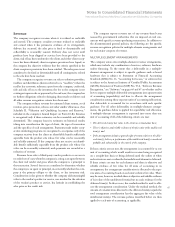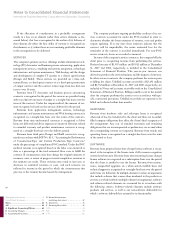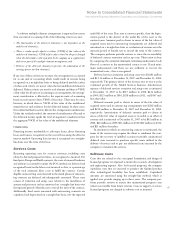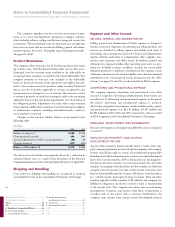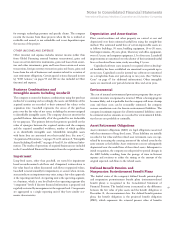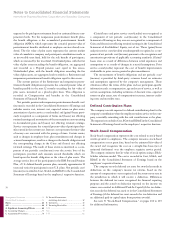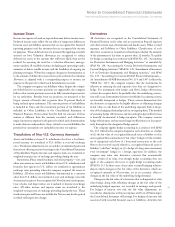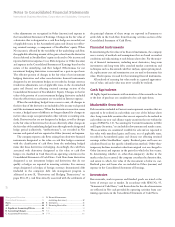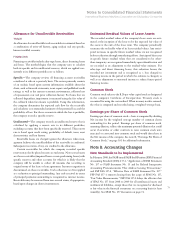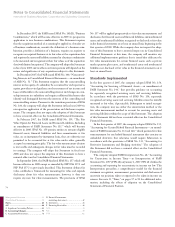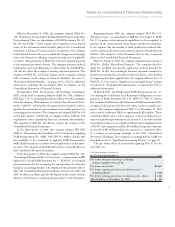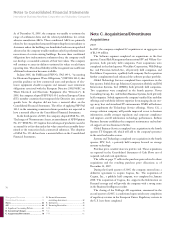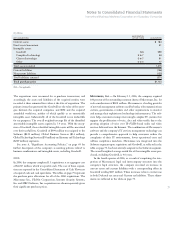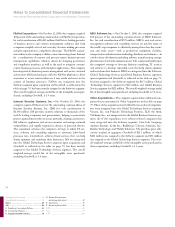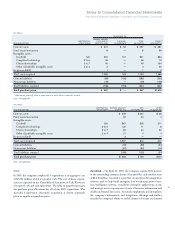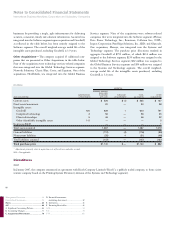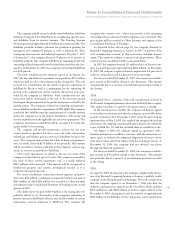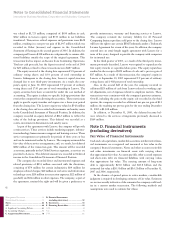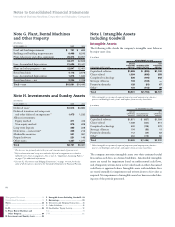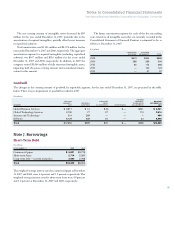IBM 2007 Annual Report Download - page 77
Download and view the complete annual report
Please find page 77 of the 2007 IBM annual report below. You can navigate through the pages in the report by either clicking on the pages listed below, or by using the keyword search tool below to find specific information within the annual report.
75
Notes to Consolidated Financial Statements
International Business Machines Corporation and Subsidiary Companies
Effective December 31, 2006, the company adopted SFAS No.
158, “Employer’s Accounting for Defined Benefit Pension and Other
Postretirement Plans, an Amendment of FASB Statements No. 87,
88, 106 and 132(R),” which requires the recognition of the funded
status of the retirement-related benefit plans in the Consolidated
Statement of Financial Position and the recognition of the changes
in that funded status in the year in which the changes occur through
Gains and (losses) not affecting retained earnings, net of applicable
tax effects. The provisions of SFAS No. 158 were adopted pursuant
to the transition provisions therein. The company measures defined
benefit plan assets and obligations as of December 31 and SFAS No.
158 did not affect the company’s existing valuation practices. The
adoption of SFAS No. 158 had no impact on the company’s existing
debt covenants, credit ratings or financial flexibility. See note U,
“Retirement-Related Benefits,” on pages 105 to 116 for additional
information, including the incremental effect of adoption on the
Consolidated Statement of Financial Position.
In September 2006, the Securities and Exchange Commission
(SEC) issued Staff Accounting Bulletin (SAB) No. 108, codified as
SAB Topic 1.N, “Considering the Effects of Prior Year Misstatements
when Quantifying Misstatements in Current Year Financial State-
ments.” SAB No. 108 describes the approach that should be used to
quantify the materiality of a misstatement and provides guidance for
correcting prior-year errors. The company early adopted SAB No. 108
in the third quarter of 2006 and accordingly, follows SAB No. 108
requirements when quantifying financial statement misstatements.
The adoption of SAB No. 108 did not require any changes to the
Consolidated Financial Statements.
In the third quarter of 2006, the company adopted FSP FIN
46(R)-6, “Determining the Variability to Be Considered in Applying
FASB Interpretation No. 46(R).” FSP FIN No. 46(R)-6 clarifies that
the variability to be considered in applying FASB Interpretation
46(R) shall be based on an analysis of the design of the variable inter-
est entity. The adoption of this FSP did not have a material effect on
the Consolidated Financial Statements.
In the first quarter of 2006, the company adopted SFAS No. 154,
“Accounting Changes and Error Corrections — a replacement of APB
Opinion No. 20 and FASB Statement No. 3.” SFAS No. 154 changed
the requirements for the accounting for and reporting of a voluntary
change in accounting principle. The adoption of this statement did not
affect the Consolidated Financial Statements in fiscal years 2007 and
2006. Its effects on future periods will depend on the nature and sig-
nificance of any future accounting changes subject to this Statement.
Beginning January 2006, the company adopted SFAS No. 151,
“Inventory Costs — an amendment of ARB No. 43, Chapter 4.” SFAS
No. 151 requires certain abnormal expenditures to be recognized as
expenses in the current period versus being capitalized in inventory.
It also requires that the amount of fixed production overhead allo-
cated to inventory be based on the normal capacity of the production
facilities. The adoption of this Statement did not have a material
effect on the Consolidated Financial Statements.
Effective January 1, 2005, the company adopted the provisions of
SFAS No. 123(R), “Share-Based Payment.” The company elected to
adopt the modified retrospective application method provided by
SFAS No. 123(R) and accordingly, financial statement amounts for
the periods presented herein reflect results as if the fair value method
of expensing had been applied from the original effective date of
SFAS No. 123. See note A, “Significant Accounting Policies,” on page
70 and note T, “Stock-Based Compensation,” on pages 102 to 105 for
additional information.
In March 2005, the FASB issued FASB Interpretation No. 47,
“Accounting for Conditional Asset Retirement Obligations, an inter-
pretation of FASB Statement No. 143” (FIN 47). FIN 47 clarifies
that conditional AROs meet the definition of liabilities and should be
recognized when incurred if their fair values can be reasonably esti-
mated. The company implemented FIN 47 at December 31, 2005
and recorded conditional AROs of approximately $85 million. These
conditional AROs relate to the company’s contractual obligations to
remove leasehold improvements in certain non-U.S. locations thereby
restoring leased space to its original condition. Upon implementation
of FIN 47, the company recorded a $36 million charge (net of income
tax benefit of $21 million) which was reported as a cumulative effect
of a change in accounting principle in the 2005 Consolidated
Statement of Earnings. The company’s accounting policy for AROs is
described in note A, “Significant Accounting Policies,” on page 69.
The pro forma effect of retroactively applying FIN 47 for the
year 2005 was:
($ in millions except per share amounts)
FOR THE YEAR ENDED DECEMBER 31: 2005
Pro forma amounts assuming accounting
change is applied retroactively:
Pro forma net income
$7,964
Pro forma earnings per share of common stock —
assuming dilution
$ 4.89
Pro forma earnings per share of common stock — basic $ 4.98
ARO liabilities at December 31, 2005 $ 85


